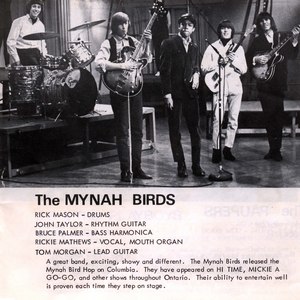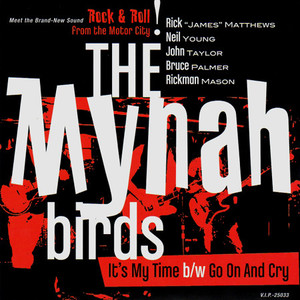Mynah Birds
Websites:
No
Origin:
Toronto, Ontario, 🇨🇦
Biography:
Formed in Toronto in 1964, The Mynah Birds were one of Canada’s most improbable and fascinating bands—a shape-shifting, interracial R&B-rock group whose brief flame included Rick James and Neil Young, and whose music was nearly released by Motown before collapsing under the weight of military scandal.
The group's roots trace back to the bohemian Yorkville scene, where a teenaged Rickie Matthews (Rick James), AWOL from the U.S. Navy, walked into the El Patio club in uniform and was invited onstage by bassist Nick St. Nicholas to sing with a loose outfit known as the Swinging Doors. Alongside Ian Gobel (guitar) and Rick Cameron (drums), the raw charisma of Matthews soon took center stage. Their popularity at the El Patio attracted the eccentric businessman Colin Kerr, who renamed them The Mynah Birds after his pet bird, Rajah, and insisted the band adopt black-and-yellow uniforms to match.
Under Kerr’s guidance, the group recorded their first Canadian single in early 1965 for Columbia Records: “The Mynah Bird Hop” backed with “The Mynah Bird Song” (C4-2660). Written by Kerr’s brother Ben Kerr, the record featured Jimmy Livingston (vocals), Frank Arnel (guitar), and Goldy McJohn (organ), and included contributions from several players who floated in and out of the lineup. Though a commercial failure, it marked Rick James’s first official studio release.
Kerr’s influence on the band extended beyond music—he often staged outrageous publicity stunts and even brought the real-life bird, Rajah, onstage, much to the chagrin of Matthews. A short CBC film was also shot at the Devil's Den club, featuring this early lineup, though the footage is now presumed lost.
By mid-1965, Bruce Palmer replaced St. Nicholas on bass, and the group distanced itself from Kerr, especially after he suggested they shave their heads to resemble mynah birds. Backed by department store heir John Craig Eaton, they revamped the lineup with musicians from Brantford's The Bunkys: Tom Morgan (lead guitar), John Taylor (rhythm guitar), and Rick Mason (drums). This version of the group adopted a Stones-inspired image and performed at clubs like the Sapphire Tavern while also touring northern Ontario.
In early 1966, Morgan departed, and Palmer recruited his former Winnipeg acquaintance: Neil Young. Young joined on 12-string electric guitar just as the band secured a deal with Motown Records. Traveling to Detroit, they recorded multiple tracks at Hitsville U.S.A. under the supervision of producers Mickey Stevenson, Michael Valvano, and R. Dean Taylor, with Smokey Robinson also reportedly involved.
Among the songs tracked during these sessions were: “It’s My Time,” “Go On and Cry,” “I Got You (In My Soul),” and “I’ll Wait Forever.” Several additional titles remain unreleased or were only documented via BMI registration, including “Out in the Country,” “Little Girl,” and other Matthews/Taylor collaborations. The group also performed with Motown artists during the sessions, and each member reportedly tracked parts individually.
A single—“It’s My Time” b/w “Go On and Cry”—was prepared for release on the V.I.P. label (catalogue no. 25033), but the plan was abandoned after Motown was informed that Matthews was a U.S. Navy deserter. Pressured by label executives, Matthews agreed to turn himself in, bringing the project to a halt.
In the aftermath, Neil Young and Bruce Palmer sold their equipment and drove a hearse to Los Angeles, where they joined forces with Stephen Stills and Richie Furay to form Buffalo Springfield. Rick James, after serving time, returned to Motown as a songwriter and producer before launching his career as a funk icon.
The Mynah Birds continued briefly: Taylor and Mason reformed the group with returning guitarist Tom Morgan, bassist John Klassen, and new vocalist Mark Smith. They played through early 1967, but the original spark was gone.
Later that year, Rick James attempted a revival with Bill Ross (guitar), Al Morrison (drums), and Neil Lillie (bass and vocals; later Neil Merryweather). They recorded two songs at Motown, "Masquerade" and "Fantasy," but the group fell apart after an internal conflict. James made another attempt in 1968 with Lillie, Bruce Cockburn (guitar), Marty Fisher (keys), and Gordon MacBain (drums), but a pending jail sentence cut the plan short. The group evolved into The Flying Circus, and later Merryweather.
Though only a few recordings ever surfaced, The Mynah Birds’ legacy remains legendary. A 2012 Record Store Day release finally issued “It’s My Time” and “Go On and Cry” on 7-inch vinyl. In 2016, Motown digitally released “I’ll Wait Forever” and “I Got You (In My Soul)” as part of their Unreleased 1966 series. Numerous other songs remain unheard.
The Mynah Birds are remembered not for what they achieved, but for what they nearly became: a band that might have fused Motown soul, British Invasion energy, and Yorkville spirit into something truly original. Their story remains one of the most captivating what-ifs in Canadian and American music history.
-Robert Williston
Rickie Mathews (Rick James): lead vocals, mouth organ (founder; AWOL from U.S. Navy; later Motown artist and funk icon)
Neil Young: lead guitar (joined early 1966; later formed Buffalo Springfield and solo legend)
Bruce Palmer: bass, harmonica (joined mid-1965; later Buffalo Springfield)
Tom Morgan: lead guitar (Columbia-era; replaced by Neil Young before Motown)
John Taylor: rhythm guitar (Columbia and Motown-era; co-writer on several tracks)
Rick Mason: drums (1965–66; featured on Columbia single and Motown sessions)
Rick Cameron: drums (1964–65; early “Sailorboys” era)
Frank Arnel (Frank Iozzo): guitar (Columbia-era; played on “Mynah Bird Hop”)
Ian Gobel: guitar (original 1964 lineup; “Sailorboys” era)
John Yachimak: guitar (short-term member in 1965)
Goldy McJohn (John Goadsby): organ (1965; later Steppenwolf)
Nick St. Nicholas: bass (1964–65; later Steppenwolf)
Richie Grand: drums (mid-1965; recalled CBC filming at Devil’s Den)
Kent Dawbney: drums (original 1964 lineup)
Jimmy Livingston: vocals (co-lead on Columbia single; later of The Tripp and Livingston’s Journey)
Domenic Troiano: guitar (brief member c.1965; later with Mandala, James Gang, Guess Who)
John Klassen: bass (1966–67 post-Motown touring lineup)
Mark Smith: vocals (1966–67 post-Motown lineup)
Bill Ross: guitar (1967 Motown revival session with Rick James)
Al Morrison: drums (1967 Motown revival session)
Neil Lillie (Neil Merryweather): bass, vocals (1967 sessions with James; later solo career)









